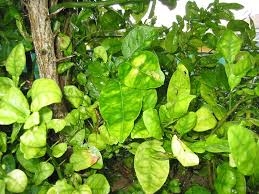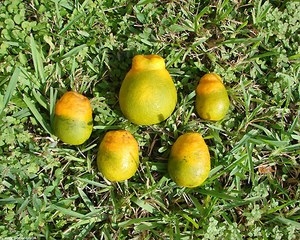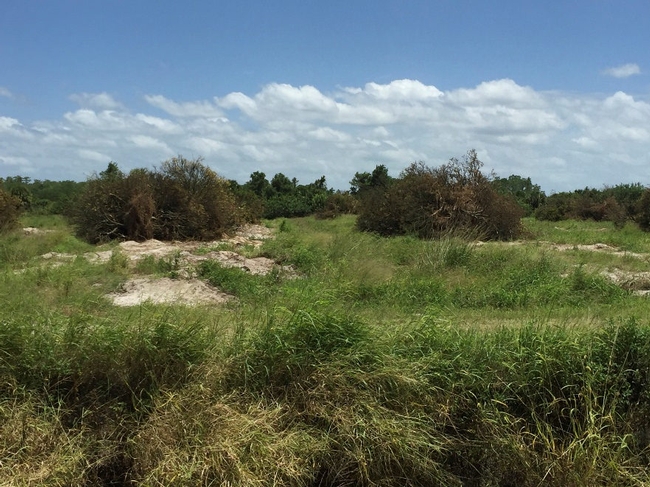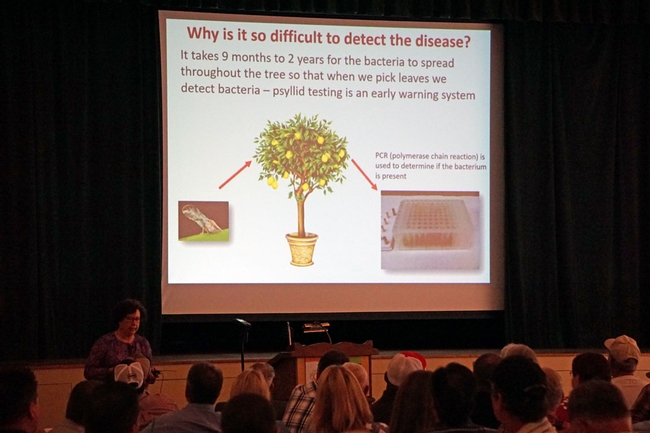
Posts Tagged: Citrus Greening
Measuring the Speed of HLB
Citrus greening disease can infect an entire tree weeks before symptoms appear
Ashley Carlin
American Phytopathological Society
For the first time ever, scientists have been able to measure the speed of a bacterium that causes the incurable citrus greening disease. Citrus greening disease (also known as Huanglongbing) is the most devastating citrus disease in the world. Afflicted trees grow yellow leaves and low-quality fruit and eventually stop producing altogether, resulting in enormous economic losses to farmers.
Small insects carry the causal bacteria, Candidatus Liberibacter asiaticus (CLas), and inject it when they feed on a tree's sap. CLas also relies on this sap to grow and spread throughout the tree. Using a new statistical modeling analysis and measurement approach, plant pathologists were able to follow CLas on its journey through a tree.
“We found that CLas can move at average speed of 2.9 to 3.8 cm per day. At these speeds a tree that is 3 meters in height will be fully colonized by CLas in around 80 to 100 days, and this is faster than the symptoms appear, which generally takes at least 4 months,” explained Silvio A. Lopes, a plant pathologist based at Fundecitrus, research institution maintained by citrus growers of the State of Sao Paulo in Brazil.
In other words, by the time growers see the symptoms of citrus greening disease, the tree has already been infected from the roots on up, which explains why removing symptomatic branches isn't enough to cure a diseased tree.
Lopes and colleagues also studied the impact of temperature on the speed of colonization. They already knew that CLas does not multiply well in hot or cold environments—but now they have more specific numbers.
“We estimated that 25.7°C (78°F) was the best condition for CLas to move from one side to the other side of the tree,” said Lopes. This is the first time impact of temperature on plant colonization of CLas has been experimentally demonstrated. “The grower can use this information to select areas less risky for planting citrus trees.”

HLB symptoms
Which Way HLB - Huanglongbing and Asian Citrus Psyllid? Now in Marin.
The best way to delay arrival of HLB in our area and minimize its impact is to keep ACP suppressed down to the lowest level possible. By treating in coordination with neighbors in an areawide approach, grower ACP treatments can have a greater impact on ACP populations than treating independently and out of sync with neighbors. Best Management Practices, such as making sure all equipment arriving and leaving your grove is free of citrus stems and leaves, can also greatly reduce the risk of HLB-positive psyllids entering your grove.
CITRUS REMOVAL PROGRAM: Citrus trees that are neglected or abandoned may harbor ACP and HLB, increasing risk to other citrus in the area. Abandoned and neglected trees may be reported to Cressida Silvers at 805-284-3310, or the county Ag Commissioner's office. The Citrus Matters ACT NOW program may be able to assist in citrus removal. For more information contact Joel Reyes at jreyes@cacitrusmutual.com or (559) 592-3790.
Asian Citrus Psyllid / ACP
There have been no ACP detections in San Luis Obispo County since our last update.
Huanglongbing / HLB
The most recent map and totals for HLB detections are posted at the website https://citrusinsider.org/maps/. As of November 16, the total number of trees that have tested positive for the HLB bacterium is 948, still all in LA, Orange, and Riverside Counties. All HLB detections have been on residential properties and the infected trees have been or are being removed. No HLB has been found in commercial groves to date.
Clarification on Field Cleaning Requirements for Movement of Bulk Citrus
To clarify the approved mitigation measures for bulk citrus fruit movement, the California Department of Food and Agriculture (CDFA) has updated the Asian Citrus Psyllid (ACP)-Free Declaration form. The current options that allow growers to meet the ACP-free standard when shipping fruit to a different ACP regional quarantine zone are the “spray and harvest,” “field cleaning with machine” and “wet wash” methods. Field cleaning must be done by machine, not by hand.
To read the full article, click here: https://citrusinsider.org/2018/11/clarification-on-field-cleaning-requirements-for-movement-of-bulk-citrus/
Upcoming CPDPC Meetings
- Joint Science and Technology Subcommittee and Regulatory Task Force meeting Thur., December 6 at 1:30 pm in Sacramento. Agenda attached, including link to join by webinar/phone.
- CPDPC Operations Subcommittee meets Wed., December 12 at 9 am in Visalia. Agenda attached with link to join by webinar/phone.
- The next meeting of the CPDPC Full Committee will be January 9 in Visalia. Agenda is pending.
- All meeting agendas and eventually the minutes are posted at https://www.cdfa.ca.gov/citruscommittee/ . All meetings are free and open to the public, and accessible via webinar.
Additional Resources
- General information on the ACP/HLB program, including quarantine information: https://citrusinsider.org/
- Biology of ACP and HLB, detection maps and recommendations for monitoring, eradication and management : http://ucanr.edu/sites/acp/
- Summaries of the latest research to combat HLB: http://ucanr.edu/sites/scienceforcitrushealth/
And Now it's in Marin County
SACRAMENTO — Marin County has been placed under quarantine for the Asian citrus psyllid (ACP) following the detection of one ACP in the City of Novato. The entire county is included in the quarantine zone.
The ACP is an invasive species of concern because it can carry the disease huanglongbing (HLB), also known as citrus greening. All citrus and closely related species, such as curry leaf trees, are susceptible hosts for both the insect and disease. There is no cure once the tree becomes infected. A diseased tree will decline in health and produce bitter, misshaped fruit until it dies. In California, HLB has been detected at residential properties in Los Angeles, Orange and Riverside counties. This plant disease does not affect human health.
Residents with backyard citrus trees in the quarantine area are asked not to transport or send citrus fruit or leaves, potted citrus trees, or curry leaves from the quarantine area. For commercial citrus, the quarantine prohibits the movement of citrus and curry leaf tree nursery stock, including all plant parts except fruit, out of the quarantine area. The quarantine also requires that all commercial citrus fruit be cleaned of leaves and stems prior to moving out of the quarantine area. An exception may be made for nursery stock and budwood grown in USDA-approved structures that are designed to keep ACP and other insects out.
ACP quarantines are in place in Alameda, Contra Costa, Fresno, Kern, Kings, Madera, Merced, Monterey, Placer, San Benito, San Joaquin, San Luis Obispo, San Mateo, Santa Clara, Solano, Stanislaus, Tulare, Yolo, Imperial, Los Angeles, Orange, Riverside, San Bernardino, San Diego, Santa Barbara, and Ventura counties, as well as Marin.
Residents in the area who think they may have seen ACP or symptoms of HLB on their trees are urged to call CDFA's Pest Hotline at 1-800-491-1899 or a local agricultural commissioner's office For more information on the ACP and HLB, please visit: www.cdfa.ca.gov/go/acp. Residents are also asked to follow these steps:
- Inspect trees for the Asian citrus psyllid and Huanglongbing monthly, and whenever watering, spraying, pruning or tending trees. Psyllids are most noticeable when new leaves are growing on the tips of the branches.
- As part of your tree care, visit your local nursery or garden center to get advice on products that can help protect your citrus tree.
- Do not move citrus plants, foliage or fruit into or out of your area, and especially across state or international borders. This could unknowingly contribute to spread of the pest and disease.
- When planting a new citrus tree, be sure to get your tree from a reputable, licensed nursery in your local area.
- When grafting citrus trees, only use registered budwood that comes with source documentation, such as the budwood offered through the Citrus Clonal Protection Program.
- Be sure to dry out citrus tree clippings or double bag them before removing the plant material from the property.
–California Department of Food and Agriculture

ACP adult and nymph
Report on HLB Research
The Citrus Research and Development Foundation (CRDF), a $124 million state citrus-industry initiative, has invested nearly 90 percent of its funds in HLB research. CRDF asked the Academies to review its research portfolio and determine if its efforts have followed recommendations outlined in the Academies' 2010 report, which originally called for the organization's creation. The committee found that CRDF was responsive to several recommendations from the previous report, and along with other funders, has advanced our knowledge about the disease. However, HLB remains a serious danger to Florida's citrus industry, having progressed from an acute to a chronic disease throughout the state.
The report notes that significant barriers to progress toward an HLB solution still exist, among them the inability to culture the bacteria in the laboratory, the lack of advanced diagnostics for early disease detection, and the absence of standardized research methodology that would improve the comparability of results across studies. Resolution of any one of these issues would constitute a significant step, according to the report.
The committee recommended continuing support for both basic and applied research for short- and long-term research efforts. In the long run, HLB solutions would likely utilize new technology, such as gene modification and gene editing, focusing on targets that mediate molecular interactions among plant, bacteria, and the vector, the committee said. As interest in using genetic modification in research grows, CRDF should also consider funding research to assess stakeholder acceptance of the technology and expand efforts to educate growers, processors, and consumers to facilitate the eventual deployment of genetically modified citrus lines.
In the meantime, growers in the state will need short-term solutions for the industry to remain viable. The report recommends finding the best suite of strategies to control the disease in different environmental and growing conditions, vector and pathogen pressures, tree varieties, and stages of tree health, which would help growers in Florida and other states where HLB also occurs.
The report also highlights the need to better understand the economic and sociological factors that impact decision-making and behaviors of growers, which influence the adoption of HLB management strategies. CRDF should create accessible databases to support sociological and economic modeling of citrus greening-related research outcomes and application projections.
The report recommends researchers communicate about the outcomes and evaluation of their efforts in a timely and systematic way. Additionally, current approaches to research prioritization and funding based within individual federal and state funding agencies have not led to development of a master plan for HLB research and subsequent management solutions. CRDF should work with other funding agencies to create an overarching advisory panel to develop a master plan for HLB research, communication, and management.
The study was sponsored by CRDF. The National Academies of Sciences, Engineering, and Medicine are private, nonprofit institutions that provide independent, objective analysis and advice to the nation to solve complex problems and inform public policy decisions related to science, technology, and medicine. The National Academies operate under an 1863 congressional charter to the National Academy of Sciences, signed by President Lincoln. For more information, visit http://national-academies.org. A roster follows.
To download full report: https://www.nap.edu/read/25026/chapter/1
Contacts:
Riya V. Anandwala, Media Relations Officer
Andrew Robinson, Media Relations Assistant
Office of News and Public Information
202-334-2138; e-mail news@nas.edu

hlb defprmed citrus
Mandarin Juice in the Morning?
In the citrus world there is a relative tolerance to the bacteria that causes Huanglongbing, or Citrus Greening. Grapefruit and some orange varieties are very sensitive and some mandarin varieties are much more tolerant, meaning they live longer in the presence of the bacteria. Work is being done to use mandarin juice as a substitute for the traditional glass of orange juice. A recent bulletin out from the University of Florida has this news. This does not mean that Asian Citrus Psyllid and Huanglongbing are any less of a threat to citrus at this point. Just a way of prolonging an industry until true solutions can be found.
GAINESVILLE, Fla. — Some people like to wake up and drink a glass of fresh Florida orange juice. With the greening disease ravaging Florida's citrus industry, University of Florida Institute of Food and Agricultural Sciences researchers want to make orange juice from disease-tolerant fruit.
Huanglongbing (HLB), or citrus greening as it's commonly called, has destroyed 80 percent of citrus in Florida, a state where citrus is an $8.6 billion-a-year industry, according to UF/IFAS research. About 90 percent of the state's oranges are used to make orange juice, UF/IFAS researchers say.
So it's critical that scientists find sources for orange juice upon which consumers can rely. UF/IFAS researchers have found some mandarins that are tolerant to citrus greening.
In a newly published study, UF/IFAS researchers also found that consumers sense little, if any difference in the smell and taste of certain specific mandarins, compared to oranges.
“We found out what makes orange taste like orange and mandarin taste like mandarin, even though they are very close species,” said Yu Wang, a UF/IFAS assistant professor of food science and human nutrition and lead author of the study.
“If we use greening-tolerant mandarin for orange-juice making, the first thing we need to know is the difference between them,” Wang said. “This will provide more possibilities and flexibilities for the citrus industry in particular in the HLB era.”
In the past, researchers used traditional methods such as gas chromatography-mass spectrometry to study the flavor differences in orange and mandarin, Wang said. But people's senses of taste and smell are much more sensitive than analytical equipment, so scientists integrated sniffing into the study, she said.
It's important to remember that oranges are descendants of mandarin and pummelos, said Fred Gmitter, a UF/IFAS horticultural sciences professor and co-author of the study. So there's already a lot of mandarin's genetic makeup in an orange.
The problem is that oranges are very sensitive to citrus greening, Gmitter said.
“While we find other selections in the breeding program, mostly mandarin, hold of up a lot better against greening, we are finding some of these selections produce fruit that more closely resemble orange in appearance,” Gmitter said. “But more importantly, here, that they also very closely resemble orange in flavor.”
The study is published in the Journal of Agricultural and Food Chemistry:
https://pubs.acs.org/doi/abs/10.1021/acs.jafc.7b04968?src=recsys
Brad Buck
UF|IFAS

mandarin
What's the HLB News from Florida?
Two more trees infected with huanglongbing (HLB) disease were identified and destroyed in the days before UC Cooperative Extension and the Citrus Research Board kicked off their spring Citrus Growers Education Seminar in Exeter June 27. The new infections raise the total number of HLB-infected trees in Los Angeles and Orange counties to 73.
The latest statistic set the stage for spirited discussions about a looming threat that cut Florida citrus production by 60 percent in 15 years. The devastating citrus losses in Florida were recounted by Ed Stover, a plant breeder with USDA Agricultural Research Service in Fort Pierce.
"One of the benefits of coming here is I am reminded how beautiful citrus is," Stover said. "In Florida, there are more than 130,000 acres of abandoned groves." He showed slides of trees with thin canopies, pale leaves and green fruit; in one image the trees were skeletons among tall weeds.
Huanglongbing disease is an incurable condition spread by Asian citrus psyllid (ACP). The psyllid, native of Pakistan, Afghanistan and other Asian regions, was first detected in California in 2008. Everywhere ACP is found, the pests find and spread HLB.
Stover and his colleagues are searching for citrus cultivars that have natural tolerance for the bacteria that causes HLB, but progress is slow. Transgenic citrus, he said, is the best bet for developing citrus with HLB immunity.
"In my opinion, commercial genetically engineered citrus is inevitable, and GE crop concerns will likely decline with time," he said.
In California, the aggressive push to keep psyllid populations low, regulations to limit the spread of psyllids when trucking the fruit, and active scouting for and removal of HLB infected trees in residential areas could buy time for researchers to find a solution before California suffers the fate of Florida citrus growers.
"Be vigilant," Stover said. "As long as you are still making a good return, there is almost no investment too great if it keeps HLB out of California."
Beth Grafton-Cardwell, UCCE citrus entomology specialist and director of the UC Lindcove Research and Extension Center near Exeter, said the prime research in the San Joaquin Valley is aimed at early detection techniques.
Once a tree is infected, it takes nine months to two years for the bacteria to spread throughout the tree, so that when leaves are selected for testing, they detect the bacteria. Capturing and testing psyllids is one way to to find the disease early. Other early detection techniques focus on the microbes, proteins and aromas produced by sick trees.
"These can be measured with leaf test, a VOC (volatile organic compound) sniffer, swab or even dogs," Grafton-Cardwell said. "Scientists are studying every conceivable way to stop the disease."
In the meantime, growers were encouraged to carefully monitor for and treat psyllid populations in their orchards with pesticides. Pesticide treatment recommendations are available on Grafton-Cardwell's Asian Citrus Psyllid Distribution and Management website, http://ucanr.edu/acp.
"We have lots of challenges," Grafton-Cardwell conceded. "We hate disrupting our beautiful integrated pest management program. But monitor your own groves, apply the most effective treatments and remove suspected (infected) trees. Going through the pain up front will save us in the long run."

HLB symptoms


